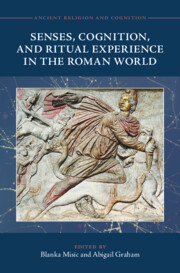Book contents
- Senses, Cognition, and Ritual Experience in the Roman World
- Ancient Religion and Cognition
- Senses, Cognition, and Ritual Experience in the Roman World
- Copyright page
- Contents
- Figures
- Contributors
- Acknowledgements
- Abbreviations
- Introduction Experiencing Rituals
- Chapter 1 Remembering the Rites: Religious Learning Network Model and Transmission of Religious Rituals in the Worship of Nutrices Augustae (Poetovio, Pannonia Superior)
- Chapter 2 The Haptic Production of Religious Knowledge among the Vestal Virgins: A Hands-On Approach to Roman Ritual
- Chapter 3 Haptic Colour: Experiential Viewing in Graeco-Roman Sacred Spaces
- Chapter 4 Nobody Is Gonna Rain on My Parade: Experiencing Salutaris’s Procession As a Ritual Event
- Chapter 5 Objects and Ritual in Egeria’s Fourth-Century Pilgrimage: The Props of My Faith
- Conclusion (Re)Creating Ritual Experiences
- Index
- References
Chapter 4 - Nobody Is Gonna Rain on My Parade: Experiencing Salutaris’s Procession As a Ritual Event
Published online by Cambridge University Press: 04 January 2024
- Senses, Cognition, and Ritual Experience in the Roman World
- Ancient Religion and Cognition
- Senses, Cognition, and Ritual Experience in the Roman World
- Copyright page
- Contents
- Figures
- Contributors
- Acknowledgements
- Abbreviations
- Introduction Experiencing Rituals
- Chapter 1 Remembering the Rites: Religious Learning Network Model and Transmission of Religious Rituals in the Worship of Nutrices Augustae (Poetovio, Pannonia Superior)
- Chapter 2 The Haptic Production of Religious Knowledge among the Vestal Virgins: A Hands-On Approach to Roman Ritual
- Chapter 3 Haptic Colour: Experiential Viewing in Graeco-Roman Sacred Spaces
- Chapter 4 Nobody Is Gonna Rain on My Parade: Experiencing Salutaris’s Procession As a Ritual Event
- Chapter 5 Objects and Ritual in Egeria’s Fourth-Century Pilgrimage: The Props of My Faith
- Conclusion (Re)Creating Ritual Experiences
- Index
- References
Summary
Processions were among the earliest ‘moving pictures’ in which the brain could develop the cognitive process of ‘reading’ a landscape and embedding a memory through sensory experiences. Salutaris’ foundation, a text inscribed outside the theatre at Ephesus which records the organization of a ritual procession for Artemis, tends to be treated as a factual guide by scholars, rather than as aspirational script for an event: repeated legal clauses, claims of control and permanency, and the white marble on which it was carved, underwrite the vivid sensual experience and transiency of a ritual event. This paper endeavors to contextualize Salutaris’ foundation by incorporating directives of the text together with an analysis of the procession as a practical event and an emotional experience. As a sensorial experience, one can explore aspects of the performance that could not be controlled: the weather, the attitude of the audience, and the behaviour of the performers. Did aspirational directives of ritual behavior come to fruition in a ritual event? How did the experience of an event shape its role and meaning? This cognitive approach provides insights to both the ritual event and the ways that processions could be read by the viewer.
Keywords
- Type
- Chapter
- Information
- Senses, Cognition, and Ritual Experience in the Roman World , pp. 118 - 166Publisher: Cambridge University PressPrint publication year: 2024



